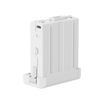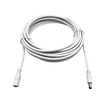Video doorbell with camera
Innovative video doorbells from Weber Protect


Razor-sharp image
The high resolution of our video doorbells delivers sharp, detailed images and videos for precise surveillance.
Motion detection
The video doorbell features advanced, AI-based people detection that precisely identifies and alerts movements.
Always available
No matter where you are, you can always stay informed about the situation on your doorstep using the Werber Protect app.
Power supply
Whether wireless for up to 180 days with the
ProV1 Wireless Video Doorbell
or directly connected to your doorbell wires with the
Cardea 2 2-wire video doorbell,
a constant power supply is always guaranteed.
Bell gong supplied
Every Weber Protect video doorbell comes with a chime that you can use at any socket in your home. You can connect any number of gongs.
Doorbell comparison
Wired or Battery-Powered? Here are the key differences at a glance



Wired
Battery, 180 days
Not necessary (mechanical)
✔
✔
✘
Person detection
Person detection
✘
Customizable detection zones
Customizable detection zones
✘
Full HD
Full HD
✘
Weber Protect App
Weber Protect App
✘
FAQ
Frequently Asked Questions about Video Doorbells
What do I need to consider with a doorbell with a camera?
Nowadays, there is a wide variety of video doorbells available on the market, and it's often challenging to choose the right one. Thanks to increasingly faster internet connections, both at home and on mobile networks, using a doorbell with your smartphone is becoming more and more common.
When making the decision to purchase, it's essential to consider what functions the video doorbell should have and what purpose it should serve. Do you only need a conventional doorbell with video capability, or do you want smart features like motion detection or app control? Weber Protect video doorbells offer much more than a traditional doorbell.
App control is a distinguishing feature of modern video doorbells with cameras. This allows you to access the doorbell at any time and from anywhere, enabling you to see visitors and communicate with them even when you're not at home.
You should also consider whether the doorbell should be used for home security. Many doorbells come with a motion sensor that can detect movement and record videos when needed. Weber Protect doorbells have such motion detection and are equipped with intelligent person recognition to register only important movements. Of course, this feature can be turned off if you prefer to use the video doorbell without surveillance.
If your front door already has doorbell wires, a hardwired 2-wire video doorbell, like the Cardea 2, is recommended. If not, you can install a battery-powered doorbell.
With the multitude of options available, it's challenging to understand the differences between various video doorbells and determine which one is right for you. Therefore, we would like to provide more details on the differences between different doorbells:
What differentiates video doorbells with cameras?
Differences can be found in many aspects of a video doorbell with a camera, including power supply, control and video transmission, data storage, etc. These differences are explained below.
Video doorbells can be either connected to doorbell wires of a doorbell transformer (2-wire) or battery-operated. It's important to check beforehand which type of power supply you prefer.
More information on power supply can be found in the FAQs under: Video Doorbell - Battery-Powered vs. Hardwired
Video doorbells also differ in control methods. Conventional video doorbells with video capabilities are usually operated with a permanently installed screen. The disadvantage here is that you can only use the video doorbell when you are directly in front of the screen.
Modern video doorbells are often operated with an app on your smartphone. The advantages are clear. With app control, you can access the video doorbell anytime and from anywhere. You will also receive notifications on your phone as soon as the doorbell is triggered.
The Weber Protect app offers you many benefits. Not only do you receive real-time notifications, but all data is processed strictly according to German GDPR regulations. Innovative encryption ensures that your data is protected and remains yours.
Data storage and video recording are another factor to consider when choosing a video doorbell. Many providers require a subscription fee to use certain functions, and you have to subscribe to an ongoing plan. Weber Protect completely avoids such a concept, and you can use all functions without any ongoing costs or subscriptions.
More about data storage and video recording can be found in the FAQs under: Video Doorbell with Subscription (Cloud) or SD Card.
Subscription (Cloud) or SD Card?
The automatic recording of videos is an essential feature of any video doorbell with a camera. When you're not near your smartphone or sleeping at night, you still want the ability to review who was at your door afterward. Therefore, the video doorbell must have the capability to automatically save videos when motion is detected or when the doorbell is pressed. There are several ways to store the images and videos from your video doorbell with a camera:
Manual Storage:
Both the ProV1 (3rd Gen) (Battery-Powered) and the Cardea 2 (2-Wire) allow you to manually save image and video data on your smartphone or tablet.
Save images and videos directly from the live video feed within the app.
Locally stored images and videos can be viewed, edited, and shared through the app or among your other photos in your gallery.
SD Card Storage:
Both of our video doorbells with cameras support automatic storage of data on a Micro SD card.
The recorded data can be accessed and viewed at any time and from anywhere via the app, without the need to remove the SD card.
If the SD card storage becomes full, old data is automatically deleted to make space for new recordings.
This service is completely free with no additional costs.
Cloud Storage:
Another option is data storage in the cloud, allowing you to access and view data via the app.
Cloud storage typically offers the ability to store images and videos, depending on the subscribed data volume.
However, cloud storage often has limitations on data retention, usually ranging from 7 to a maximum of 30 days.
After that period, the image and video data are deleted and no longer accessible.
Cloud storage services may also come with additional costs.
We recommend using the data storage option on a inserted Micro SD card, as it does not incur ongoing costs or require subscriptions.
How does a video doorbell work?
Video doorbells are becoming increasingly popular due to their many advantages and cost-effectiveness. But how do video doorbells actually work, and can a video doorbell truly replace your existing intercom system?
Video doorbells come in various variations but operate on similar principles. They are typically installed at your front door, replacing your traditional doorbell. They can be powered either by a built-in battery or by being wired to your existing doorbell transformer.
Here's how video doorbells generally work:
- Installation: You mount the video doorbell at your front door, just like a traditional doorbell.
- Power Source: Video doorbells can be powered by a rechargeable battery or wired to your existing doorbell transformer. Battery-powered models are often easier to install as they don't require wiring.
- Wi-Fi Connection: Video doorbells connect to your home's Wi-Fi network. Each video doorbell has a unique device ID that is linked to your app account, ensuring that only you have access to your doorbell and camera.
- App Control: Video doorbells are controlled through a mobile app. After connecting the doorbell to your app account, you'll need to enter your Wi-Fi password into the app. The app will generate a QR code, which is scanned by the doorbell's camera. This process establishes a connection between the video doorbell and your Wi-Fi network. It typically takes just a few minutes to set up.
- Live Video Feed: Once connected, you can access a live video feed from the doorbell's camera through the mobile app. This allows you to see who is at your front door in real-time.
- Two-Way Communication: Most video doorbells offer two-way audio communication. You can speak to visitors at your door using the microphone and speaker on the doorbell and hear their responses through the app.
- Notifications: The video doorbell sends notifications to your smartphone when someone presses the doorbell button or when motion is detected near your front door.
- Video Recording: Video doorbells can record video clips when triggered by motion or when the doorbell is pressed. These recordings can be stored in the cloud or on a local storage device, such as an SD card.
- Remote Access: Because video doorbells are connected to the internet, you can access the live video feed and recorded videos remotely from anywhere with an internet connection.
- Security Alerts: Video doorbells can provide security alerts for various events, enhancing your home's security.
In summary, video doorbells replace traditional doorbells and offer additional features like live video feeds, two-way communication, and remote access through a mobile app. They can be powered by batteries or wired to your existing doorbell system, making them versatile and easy to install.
Can the video doorbell replace a traditional intercom system?
In short, yes, it can, but only if certain conditions are met. Before replacing your intercom system with a new video doorbell, the following should be clarified:
Is my Wi-Fi strong enough?
The Wi-Fi speed and signal strength are crucial for the operation of your video doorbell. The stronger the signal, the smoother the operation. You should achieve the following minimum speed consistently at the installation location:
- Download speed: 10Mbps
- Upload speed: min. 5Mbps
For optimal operation, both the download and upload speeds should be above 10Mbps. Please note that the Wi-Fi test at the installation location should be conducted with closed doors.
Smartphone or Tablet?
Video doorbells must be controlled from one of your devices. The Weber Protect App works on Android and Apple iOS devices. Check in advance if and with which phone or tablet you want to connect the video doorbell. Connection can only be made via Apple iOS or Android devices. If you also want to access the video doorbell and receive notifications outside your home, you need to be connected to the internet via mobile data.
Video doorbell Wi-Fi connection
A stable Wi-Fi connection at the installation location is a basic requirement for the operation of a video doorbell. Therefore, we recommend checking the internet speed at the desired installation location before purchasing a video doorbell.
But how can you determine if your Wi-Fi reception is sufficient? You can perform a quick test with your smartphone for this purpose. Take your phone to the desired installation location. Make sure your smartphone stays connected to your Wi-Fi throughout the test and doesn't switch to mobile data.
Now, open your smartphone's browser and enter "Internet Speedtest" into Google. Click on the blue button that says "Run Speed Test" and wait for the internet speed to be determined.
The following Wi-Fi parameters should be met for optimal operation:
- Download Speed: 10 Mbps
- Upload Speed: at least 5 Mbps
In addition, please consider the following:
- Do not mount the video doorbell directly on or in close proximity to metal, as this can cause significant Wi-Fi reception interference.
If the above parameters are met, you can easily install and operate your Weber Protect video doorbell at that location.
How do I install a video doorbell?
Installing a doorbell may seem daunting at first, but it can be a straightforward process. Here are the steps for installing a video doorbell:
- Choose the Power Source:
Decide whether you want to power your video doorbell with batteries or through wiring it to your existing doorbell transformer. Some video doorbells can be battery-operated (e.g., ProV1), while others can be hardwired (e.g., Cardea) and connected to your existing doorbell transformer or a power outlet. - Select the Installation Location:
Identify the optimal location for installing the video doorbell. Ensure that there is a stable Wi-Fi connection at the chosen location, and the internet speed is sufficient. Additionally, consider the mounting surface, and avoid locations with metal or reinforced concrete, as they can interfere with the Wi-Fi signal. - Connect to Wi-Fi:
To connect your video doorbell to Wi-Fi, go near your router or Wi-Fi repeater, turn on the doorbell, and open the Weber Protect App. Create an App account if you haven't already. Enter your Wi-Fi information into the app, and it will generate a QR code. The doorbell's camera will automatically scan the QR code to establish a connection with your Wi-Fi network. - Mount the Doorbell:
Depending on the model, mount the video doorbell using the appropriate method. For example, the ProV1 can be easily attached using screws or adhesive. The Cardea, if hardwired, needs to be connected to your existing doorbell wires. All necessary installation materials are included in the package. - Complete Installation:
After attaching the video doorbell to the chosen location, it will automatically reconnect to your Wi-Fi network. The installation is now complete.
The installation process is designed to be user-friendly and can be done without specialized knowledge or the need for an electrician.
Installing a doorbell may seem daunting at first, but it can be a straightforward process. Here are the steps for installing a video doorbell:
- Choose the Power Source:
Decide whether you want to power your video doorbell with batteries or through wiring it to your existing doorbell transformer. Some video doorbells can be battery-operated (e.g., ProV1), while others can be hardwired (e.g., Cardea) and connected to your existing doorbell transformer or a power outlet. - Select the Installation Location:
Identify the optimal location for installing the video doorbell. Ensure that there is a stable Wi-Fi connection at the chosen location, and the internet speed is sufficient. Additionally, consider the mounting surface, and avoid locations with metal or reinforced concrete, as they can interfere with the Wi-Fi signal. - Connect to Wi-Fi:
To connect your video doorbell to Wi-Fi, go near your router or Wi-Fi repeater, turn on the doorbell, and open the Weber Protect App. Create an App account if you haven't already. Enter your Wi-Fi information into the app, and it will generate a QR code. The doorbell's camera will automatically scan the QR code to establish a connection with your Wi-Fi network. - Mount the Doorbell:
Depending on the model, mount the video doorbell using the appropriate method. For example, the ProV1 can be easily attached using screws or adhesive. The Cardea, if hardwired, needs to be connected to your existing doorbell wires. All necessary installation materials are included in the package. - Complete Installation:
After attaching the video doorbell to the chosen location, it will automatically reconnect to your Wi-Fi network. The installation is now complete.
The installation process is designed to be user-friendly and can be done without specialized knowledge or the need for an electrician.
Wireless or Wired?
Video doorbells can be powered by one of two methods. They either have a built-in battery, or they are connected to the wires of a doorbell transformer. Both options have their advantages and disadvantages:
Hardwired video doorbells offer the advantage of being always ready for use, and you never have to recharge a battery. However, they have limited flexibility in choosing the installation location, as they need to be mounted where your doorbell wires are located. If the doorbell wires are positioned very low, for example, the video doorbell may not capture the entire person in front of the camera. The optimal mounting height for a video doorbell with a camera is approximately 1.50 meters. If your doorbell wires are significantly below this height or are not present at all, it is recommended to purchase a battery-operated video doorbell with a camera.
A battery-operated video doorbell offers the advantage of flexibility and can be installed anywhere. This allows you to position it in a way that optimally captures the door area. However, battery-operated doorbells need to be regularly recharged. Therefore, when choosing a battery doorbell, it's essential to pay attention to the battery capacity and battery life. For example, the ProV1 3rd Gen has a battery with a high capacity of 10,000 mAh and a very long battery life of up to 180 days.
Alternatively, the video doorbell with a camera can also be connected to your doorbell transformer (ProV1 - AC 12V-24V / Cardea - AC 12V -24V / DC 12V). Hardwiring is a bit more complicated initially because you need to connect the existing doorbell wires (from the doorbell transformer) to the video doorbell. This requires attaching your existing doorbell wires to the back of the video doorbell using the provided mounting materials.
Doorbells with mobile phone calls?
The control of Weber Protect doorbells is done through the app on your mobile phone. All functions, such as the intercom feature and live video, are controlled through the app and your smartphone.
When a visitor rings the video doorbell, you will immediately receive a notification on your smartphone. Once you accept the notification, you will be directed to the video and intercom function. This allows you to speak with people at your door from anywhere, and you'll never miss a visitor again.
You will also receive immediate notifications on your phone for motion detection events. In addition to the notification, a video of the motion is automatically recorded so that you can review who was at your doorstep later.
Not only do calls from the doorbell and motion detection events get transmitted to your phone, but all functions of the video doorbell, including battery management, settings, family management, etc., are controlled through the Weber Protect app on your smartphone. This means you have full control over your front door from anywhere and at any time through your mobile device.
Can the doorbell be used outside of the Wi-Fi network?
Access to all functions is possible anytime and from anywhere. The connected mobile devices do not need to be on the same Wi-Fi network as the doorbell; they can access the live video and intercom function using mobile data or other Wi-Fi networks at any time. Only the video doorbell itself needs to be continuously connected to a Wi-Fi network. The mobile devices being used can also be logged into different networks, and all of them can simultaneously use all functions.
Can I combine the doorbell with other Weber Protect products?
You can connect as many Weber Protect products as you want to the app and control them simultaneously. For example, you can use surveillance cameras and video doorbells simultaneously. Devices in different locations, such as at home and in the office, can also be controlled simultaneously. There is no limit to the number of connected devices.

Wenn es früh dunkel wird und viele Menschen unterwegs sind, steigt das Risiko für Haus‑ und Wohnungseinbrüche deutlich. In diesem Blogartikel zeigen wir, warum Einbrecher im Winter aktiv werden, we...

Wir wünschen einen guten Start ins neue Jahr – Ein Rückblick auf 2025 und Ausblick auf 2026
Ein weiteres spannendes Jahr liegt hinter uns, und das gesamte Team von Weber Protect möchte sich bei Ihnen herzlich bedanken. 2026 wird für uns ein Jahr voller Innovationen, Weiterentwicklungen un...

Überwachungskamera im Winter: Nachtsicht, Fehlalarme & optimale Einstellungen
Genau hier setzt dieser Artikel an: Du erfährst, warum Überwachungskameras im Winter problematischer reagieren, wie moderne Technik (z. B. KI‑Erkennung) hilft und wie du deine Kamera optimal einste...
































